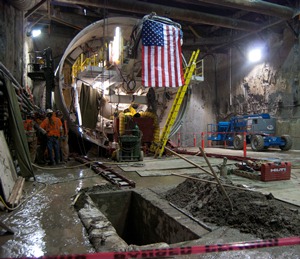Tunneling 100 ft below a busy city with varying substructure is a delicate job, especially when the work comes within 8 ft of existing tunnels. Such is the case on San Francisco's new $1.5-billion Central Subway Project, which began major subterranean excavation last month.

"The tunnels pass through both soft ground and Franciscan formation, which is heterogeneous rock that is not predictable except in its unpredictability," says Sarah Wilson, a San Francisco Municipal Transportation Agency (SFMTA) resident engineer.
While underground conditions will be tricky, the project's twin earth-pressure-balance tunnel-boring machines will be able to adjust their blades and cut through any sand, dirt or rock, says Wilson. The TBMs, dubbed Mom Chung and Big Alma, are each 350 ft long and weigh 750 tons.
Mom Chung was first out of the 450-ft-long launch box. Over the next 10 months, she will travel north, creating a 1.7-mile-long tunnel. Big Alma will begin digging a southbound parallel tunnel later this month.
The tunnels are the main component of the Central Subway Project, which is extending the Muni Metro T Third Line through one of the most densely populated neighborhoods in the U.S. with three new underground stations and one at street level.
A joint venture of Barnard Impregilo Healy, Bozeman, Mont., is the lead tunneling contractor. Tutor Perini, Sylmar, Calif., is leading construction of stations, tracks and operating systems. Work on the line is scheduled to wrap up in 2019.
Project officials say that one of the biggest challenges of the job will be traveling under two existing BART tunnels.
"We’ve been studying the crossings for about 10 years and we have very good characterization of the soils and we have records of the initial construction of the Muni Metro along Market Street, so we have a very good handle on what we are about to encounter," says John Funghi, SFMTA program director.
To help things go smoothly, SFMTA has set up an independent review panel to study the progress and to interface with BART. They also equipped the TBMs with real-time geotechnical instrumentation monitoring, so the project team can watch data flows on their computers or cell phones to see how individual structures, utilities, sidewalks, and points of interest along the alignment is being affected.
"It's working pretty well," says Wilson. "We've observed hundredths of an inch of movement of the mined tunnel so far, right where we expected the movement to be."
To prevent and control ground and adjacent structure settlement, the team will use compensation grouting, which involves a horizontal array of grout pipes installed into a shaft that is drilled down next to the tunnel alignment.
"Essentially, we are moving any weaknesses in the ground and injecting it with a high-pressure cement slurry, so we are basically preconditioning the ground and making it homogeneous so that there are no surprises for the crossing,” says Funghi.
Mom Chung and Big Alma will excavate and construct the tunnels at a pace of approximately 40 ft per day. Project officials say that the TBMs will be so far beneath the surface – between 40 and 120 ft underground – that no vibration or noise will be felt above ground when they pass below.


Post a comment to this article
Report Abusive Comment